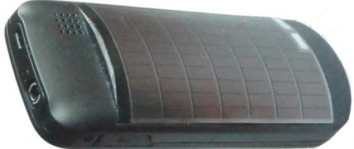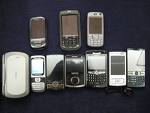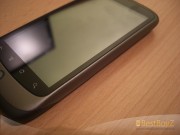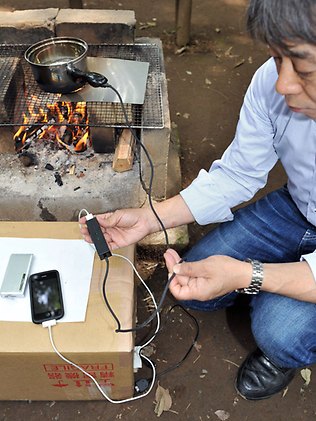Now we know that flip phones are trending again, are we also expecting Android sliding phones to make a comeback? Touch screen phones have only graced us in the last decade or so. In between that transition from keypad phones to touchpad mobile devices, we have slider phones. We can consider slider phones as the transition feature between these two different technologies. Or, maybe, the “missing link” connecting the past and futures of mobile devices.
[Read more…]Google Nexus One vs Google Nexus Prime
When Google released its flagship smartphone product the Nexus One, it received rave reviews and has continued to be a player on the portable device market. Now two models removed from the original, we see how the Nexus One stacks up against the yet to be released Nexus Prime.
Dimensions and Form
• Google Nexus One – 119 x 59.8 x 11.5mm, 130g
• Google Nexus Prime – Unreleased
The minimalist shape and chrome build of the Nexus One has been a popular aesthetic with many critics. The screen uses up the majority of space, and this always improves the look of portable devices. The touch-sensitive buttons and fluid track ball juxtapose nicely with the overall countenance. It’s patently obvious that Google is fond of the design, as the Nexus Prime shows little alteration in this regard.
Winner: Draw
Display Screen
• Google Nexus One – 3.7 inch AMOLED capacitive touchscreen, 480×800 pixel resolution
• Google Nexus Prime – 4.7 inch, 1280 x 720 pixel resolution with Samsung PenTile Matrix Technology
While the builds are similar, the Nexus Prime’s significantly larger screen sets it apart from the Nexus One. Despite the quality of the Nexus One’s 252 pixel per inch AMOLED screen, it is hard pressed to compete with what is rumored to be the first 720p smartphone. Other features likely to be included are multi-touch and an accelerometer sensor.
Winner: Google Nexus Prime
Processing Power and Memory
• Google Nexus One – 1GHz Qualcomm Scorpion processor with Adreno 200 GPU, 512MB RAM
• Google Nexus Prime – 1.5GHz dual core TI OMAP4460 CPU and a PowerVR SGX540 GPU, 1GB RAM
The Nexus One was potent for its time, backing its 1GHz Scorpion processor with an Adreno 200 GPU and 512MB of RAM. Yet as we begin to see dual core processors become standard in tablets, it isn’t surprising that the architecture would eventually find its way to smartphones. The Nexus Prime is said to boast a brawny 1.5GHz dual core TI OMAP4460 processor supplemented by a PowerVR SGX540 GPU and 1GB RAM, revolutionary for a device that fits in the palm of your hand.
Operating System
• Google Nexus One – Android 2.4 Gingerbread
• Google Nexus Prime – Android Ice Cream Sandwich
The Nexus Prime once more is the beneficiary of a next generation upgrade, as the smartphone will roll out with the much anticipated Android Ice Cream Sandwich. Currently, the Nexus One runs Android 2.4 Gingerbread, yet it too will reportedly be upgrading to the next generation software.
Designed for both tablets and smartphones, Google has stated that Ice Cream should end the fragmentation that has occurred with its various iterations such as Gingerbread and Honeycomb. Ice Cream combines the best of these operating systems in a more efficient, app and multi-tasking friendly experience, including enhanced Javascript and Open GL graphics acceleration. Browsing promises to be much smoother than on the clunkier Gingerbread, and Google has also indicated Ice Cream will have voice and facial detection software included.
Winner: Draw
Camera
• Google Nexus One – 5 MP primary camera
• Google Nexus Prime – 5 MP primary camera with 2560 x 1920 pixel resolution, 2 MP secondary camera
The Nexus Prime is reported to have a 5 megapixel primary camera that is capable of full 1080p HD video capture. In addition, the camera should come equipped with the usual features, such as auto-focus, digital zoom, and a secondary camera for video calling, but the video capture is DVD quality.
Winner: Google Nexus Prime
Conclusion
As the newer model, the Google Nexus Prime is naturally the more advanced device. Yet the difference between the two models is staggering, considering the dual core processor, the 720p display, and the 1080p video capture in the Nexus Prime. For Nexus One owners, truly this is a case where the cost of an upgrade is justified.
Article written by Sarah Richards from MobileBroadband.net. Sarah writes on a wide range of broadband topics including 3 broadband reviews.
A USB Charger That Leaches Power For You
 Haven’t you guys noticed that we’re getting more and more reliant on our gadgets? We rely on our smart phones, tablets, computers and whatever else you use on a daily basis for many important tasks. But our gadgets are not “immortal” so to speak. They need power to run. I’m pretty sure you guys have experienced seeing that red blinking light on your device that indicates your gadget is about to die but you have a desperate use for it. [Read more…]
Haven’t you guys noticed that we’re getting more and more reliant on our gadgets? We rely on our smart phones, tablets, computers and whatever else you use on a daily basis for many important tasks. But our gadgets are not “immortal” so to speak. They need power to run. I’m pretty sure you guys have experienced seeing that red blinking light on your device that indicates your gadget is about to die but you have a desperate use for it. [Read more…]
Nokia testing solar powered phones
 The green movement is sweeping the planet. More and more users are becoming more aware of the environment and their impact on it and are taking measures to help out. Manufacturers are also slowly getting on the bandwagon and are taking their own measures to make make their own contributions as well. [Read more…]
The green movement is sweeping the planet. More and more users are becoming more aware of the environment and their impact on it and are taking measures to help out. Manufacturers are also slowly getting on the bandwagon and are taking their own measures to make make their own contributions as well. [Read more…]
Hatsuden-Nabe Thermo-electric Cookpot: Cell Phone Charger for Natural Disasters
With natural disasters occurring practically every day – at least in some parts of the world, it is only common sense to do as much as you can in case you actually find yourself in the middle of an emergency – or even the aftermath. We have emergency kits, first aid kits, and all sorts of other kits that can help keep you alive.
What Japanese company TES NewEnergy has done is to add to the arsenal of emergency supplies that everyone has to have. Think about it – after an earthquake, a typhoon, or a flood, electrical power may not be readily available. You might find yourself camping out in an area where there are no facilities. Even evacuation centers may not have a steady supply of electrical power. You probably will have some gadget that needs electricity – chances are that you will have your mobile phone; maybe you’ll have an mp3 player. While these things may be frivolous in times of a natural disaster, they can help survivors make their situation a tad better. Your cell phone can be used to call relatives and friends. It can be used to call for help. At the very least, if your situation is not that bad, it can be used to amuse yourself. The problem is if you’re out of juice.
That’s where TES NewEnergy’s gadget comes into the picture. It is basically a cookpot which can be placed over a campfire. At the end of the pot’s handle comes out a wire which has a USB connector at the end. This connector can then be used to hook up a mobile phone or any other compatible gadget, allowing for the transfer of electric power. This is made possible by the temperature differential between the bottom of the pot (which can reach up to 550 degrees Celsius) and the boiling water that the pot contains (100 degrees Celsius). With this set up, it can take anywhere from three to five hours to fully charge an iPhone. At the same time, you can make lunch or heat it up!
The use of the pot is not limited to emergency situations. The gadget can also be used in places where electricity is not yet available. When you go camping, you can also lug this pot around – it is small enough to carry around.
The gadget is already available in Japan for $284.55, and the company is planning on marketing it in other parts of the world soon.
New Study by WHO: Mobile Phones Increases Cancer Risk
To that, my immediate response was “No s–t, Sherlock!” Seriously, I remember a time when there were only two families in our entire subdivision who had mobile phones. There was a time when only a handful of students had mobile phones in class. And those mobile phones were not so mobile as they are now.
Way back then, the issue of increased cancer risk was already being brought up. There were studies – supposedly – being conducted. Then some years later, most every health organization in the world took the stand that the studies were inconclusive and that it was safe for the general public to continue living their lives connected to their mobile phones.
As things would have it, the tides have changed yet again. An agency under the World Health Organization has released the findings of a study on the effects of prolonged cellphone use on humans. ((LA Times)) The findings point to the possibility of increasing the chance of forming two kinds of tumors. The good news is that one is not cancerous. Called acoustic neuroma, this noncancerous tumor forms in the nerve that goes from the ear to the brain.
The bad news – aside from the fact that you have been excessively using that mobile phone in the past years thinking that you were totally safe – is that the other tumor is cancerous. This other possibility is called glioma, a specific kind of brain cancer.
The frustrating – but expected – thing is that WHO says that the study does not have definitive findings and that further tracking is necessary. The organization does, however, state that the risk for these health problems roughly doubles after 10 years (a decade) of cellphone use. So I have been using a cellphone for more than 10 years – shall I go have a CT scan or MRI now?
Seriously, though, many other researchers and scientists do not agree with WHO at this point. They belong to the school of thought that upholds studies showing that there is no link between brain cancer and mobile phone usage.
As for us mere gadget lovers/users, we can only sit back and read about what the researchers come up with. One question that I would like to pose is this: WHO being a respected body, how are you going to take their advisory about cellphone use? Will this piece of news (rather stale, I think) affect how you use your mobile phone?
Photo via Ed Yourdon
Coverage… It’s All About Coverage
Nahhh…… not about the skimpy clothes the girl who passed by is wearing but rather the coverage of the many networks that are offering mobiles all over the place. Carriers offer mobile phone units for free in exchange for subscriptions to their mobile plans which is the norm in the industry. The mobile phone invasion has resulted in a whole generation of people who cannot exist without their mobiles that just keep on getting better and smaller.

Though most carriers have expanded their coverage areas, it is still wise to compare cell phone coverage areas for the best deal. Though dead-spots may never be eliminated, the larger the area coverage, the better, so you don’t get a no coverage message as you make an emergency call. The huge expanse of the US being one solid mass is easy to cover with satellite and land-based site antennas but even in the most developed areas, too much interference or noise as it is called can interfere with your mobile’s signal.
CellPhones…CellPhones Everywhere…
 Everybody’s sure to have a mobile device today for it has revolutionized the way we communicate with each other. It has created a niche in popular society, responsible for words such as SMS, Texting, Twitter, iReports and many more as testament to our reliance on the said technological wonder. Some love them some hate them but you’d have to give credit that without it, we would still be living in an age where phones had wires.
Everybody’s sure to have a mobile device today for it has revolutionized the way we communicate with each other. It has created a niche in popular society, responsible for words such as SMS, Texting, Twitter, iReports and many more as testament to our reliance on the said technological wonder. Some love them some hate them but you’d have to give credit that without it, we would still be living in an age where phones had wires.

Cellular phones are one of the most prolific, intrusive and indispensable technologies we have and they pack a lot of technology in so small a package. From a radio phone, GPS device, digital still and video Camera and a personal digital assistant device, they have all managed to fit in one small box that gives us all the conveniences of communication whatever form it may be.



